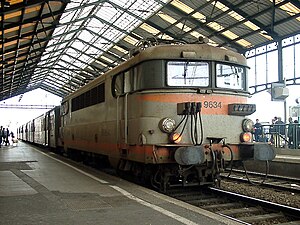SNCF BB 9600
| BB 9600 | |
|---|---|
|
BB 9634 in 2003
|
|
| Numbering: | 9601-9642 |
| Number: | 42 |
| Manufacturer: | Béziers repair shop |
| Year of construction (s): | 1990–1994 through conversion from BB 9400 |
| Retirement: | 2004-2007 |
| Axis formula : | B'B ' |
| Gauge : | 1435 mm ( standard gauge ) |
| Length over buffers: | 14,400 mm |
| Height: | 3,550 mm |
| Width: | 2,980 mm |
| Trunnion Distance: | 8,200 mm |
| Bogie axle base: | 2,200 mm |
| Total wheelbase: | 10,400 mm |
| Service mass: | 67 t |
| Friction mass: | 67 t |
| Wheel set mass : | 17 t |
| Top speed: | 140 km / h |
| Continuous output : | 2,210 kW |
| Driving wheel diameter: | 1,020 mm |
| Power system : | 1.5 kV direct current |
| Power transmission: | Overhead line 2 pantographs (type; AM14) |
| Number of traction motors: | 2 (type; SW 408) |
The BB 9600 was a French electric locomotive series for use on the direct current network of the SNCF with 1.5 kV voltage . The locomotives were created by converting the BB 9400 between 1990 and 1994 for the transport of push-pull trains . 42 copies of the locomotives were converted and were in use in this form until 2007.
history

When the idea of using push- pull trains in the form of RRR trains for light regional traffic arose in France in the early 1990s , suitable locomotives were sought for the haulage. Originally the BB 8500 was supposed to take over these services. Since this locomotive was intended more for freight train service, the SNCF decided to convert 42 locomotives of the BB 9400 series for these services. The Béziers repair shop was selected as the renovation workshop , and the best-preserved specimens from the dispenser series were selected for the renovation. In August 1991, the BB 9601, the first locomotive for suburban traffic, was delivered, which carried its first journey on the line from Avignon to Carcassonne and back.
During the conversion, the mechanical equipment of the locomotive was essentially left unchanged, only the top speed was increased to 140 km / h. The electrical equipment of the locomotive has been completely redesigned; Instead of the conventional resistance control, the converted locomotives were controlled by a PLC control . The locomotive was also given push-pull control and the locomotive's cab was completely renewed. The redesign of the electrical equipment increased the service weight from 60 t to 67 t. The majority of the locomotives selected were those with an arrangement of the single-arm pantographs on small blocks of the roof shape. Some vehicles with single-arm pantographs placed on a frame were also used, whereby, as with the BB 9617, a new design of the pantograph holder was selected. The locomotives BB 9601–9640 were painted with a concrete-gray roof and car body with yellow decorative lines and dark gray ribbon windows. The last delivered BB 9641/9642 were painted differently by being painted according to the TGV Atlantique , they were intended for the operation of the push-pull trains between Tours and Saint-Pierre-des-Corps .
The locomotives were in service with push-pull trains for about ten years. E.g. on the routes Tours - Saint-Pierre-des-Corps , Lyon - Avignon , Lyon - Ambérieux , Lyon - St-Etienne , Lyon - Nîmes , Neussargues - Béziers or Perpignan – Villefranche . Their use did not always go smoothly; there should have been problems in the heating of the trains. The locomotives were used in the Avignon, Tours-Saint-Pierre and Vénissieux depots . The push- pull trains were replaced on the operational routes by multiple units , first with the Z 5300 , and finally with the Z 23500 . The first vehicles left their service from 2000, and from 2008 the vehicles are considered retired.
Web links
- Website about the BB 9600 series (French)
- Website about the conversion of the locomotives BB 9600 from the BB 9400 (French)
